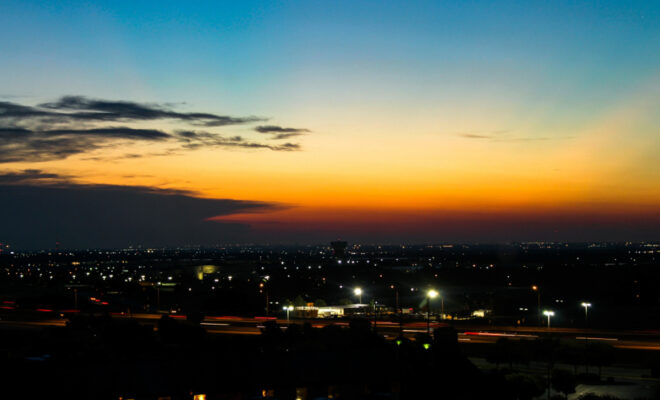In this article, we’ll explore why the sky sometimes turns yellow at night. This can be intriguing, especially for those without a background in astronomy or meteorology. Our goal is to provide clear and detailed information to help you understand this phenomenon. So, ready to learn more about this captivating topic? Let’s start with an introduction to the different causes of the yellow color of the night sky.
Light pollution
Light pollution is one of the main causes of the yellow color of the night sky. Indeed, artificial lighting is omnipresent in urbanized areas, which leads to excessive lighting of the sky. Street lights, advertising signs, illuminated buildings and other light sources contribute to this phenomenon.
Most artificial lighting sources use incandescent bulbs, which emit light rich in yellow and orange wavelengths. This light disperses in the atmosphere and gives the sky a yellowish tint. Light pollution can also obscure stars and other celestial objects, making the night sky less spectacular.
Scattering of light by the atmosphere
Earth’s atmosphere plays a crucial role in scattering light, and this influences the color of the sky. Light scattering occurs when air molecules and particles suspended in the atmosphere interact with different wavelengths of light.
Rayleigh scattering is a process that particularly affects short wavelengths, such as blue and violet. In contrast, yellow and red wavelengths are less affected. So when light from the sun or moon passes through the atmosphere at a low angle, the blue and violet wavelengths are scattered more, giving the sky a yellowish tint.
Weather and environmental phenomena
Various weather and environmental phenomena can also cause the sky to appear yellow at night. For example, the presence of dust, fumes or pollutants in the atmosphere can affect the way light scatters. These particles absorb and reflect light, which can change the color of the sky.
Another environmental factor is the presence of clouds. Clouds, especially low-lying clouds, can reflect artificial and natural light, giving the sky a yellowish tint. Sky color can also be affected by weather phenomena such as thunderstorms, which are accompanied by lightning and glows producing yellow light.
Also read: Combine Charm And Prestige By Choosing A Castle For Your Reception
Solutions to reduce the yellow color of the night sky
Fortunately, there are solutions to reduce the yellow color of the night sky and minimize the impact of light pollution. First of all, it is essential to promote the use of less polluting lighting sources, such as LED lamps, which emit white light and consume less energy.
Then, cities and municipalities can put regulations in place to limit excessive lighting, such as turning off advertising signs and streetlights during certain hours of the night. Finally, each of us can help reduce light pollution by turning off unnecessary lights and using blackout blinds or curtains to block incoming light.
In sum, the yellow color of the night sky is mainly due to light pollution, the scattering of light by the atmosphere, and various meteorological and environmental phenomena. It is important to be aware of the impact of light pollution on our environment and to adopt measures to reduce this problem. This way, we will be able to enjoy darker, starry night skies, and preserve our environment for future generations.


